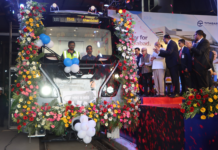New Delhi, India (Metro Rail News): In a significant boost to provide last-mile connectivity to metro commuters, Delhi Metro Rail Corporation Limited (DMRC) on Feb 19, 2020, extended the facility of e-rickshaw services to 12 more stations spread across the Metro Rail network.
With this, the total tally of stations where such facilities available to 29 with an operational fleet of over 1000 e-rickshaws.
A K Garg, Director (Operations), has flagged off a fleet of around new 250 e-rickshaws, from Patel Nagar Metro.
These e-rickshaws will be plying from 12 metro stations, i.e. Qutab Minar, Ghittorni, Arjangarh, Nawada, Shadipur, Patel Nagar, Nangloi, Nangloi Railway Station, Govindpuri, Harkesh Nagar Okhla, Moolchand and Botanical Garden between 6.00 am to 11.00 pm every day.
“Till date, to facilitating over one lakh passengers to reach their destinations/stations daily, 800 e-rickshaws being operated from 17 Metro stations. With this addition, the number of e-rickshaws has gone beyond 1,000, covering 29 metro stations,” the DMRC said in a statement.
Twelve more stations are likely to be added in the next 2-3 months wherein around 500 more e-rickshaws will be put into service to strengthen the last mile connectivity
These GPS enabled rickshaws called “SmartEs” having covered cabin and full front windscreen, will provide the last mile connectivity within a radius of 3-4 km around Metro stations.
The fares have been kept very nominal at a base price of Rs 10 for the first 2 KM and Rs 5/- for every subsequent KM. The commuters can also book vehicles through the SmartE application and pay digitally for their rides, the official said.
In recent years, DMRC has introduced many eco-friendly initiatives to ensure a robust last-mile connectivity system, which enables the commuters to prefer non-polluting public transport modes over personal vehicles.






